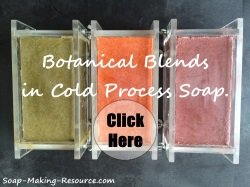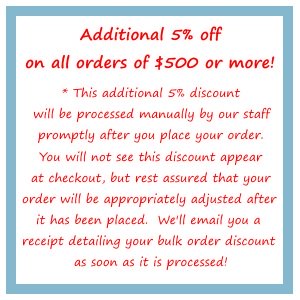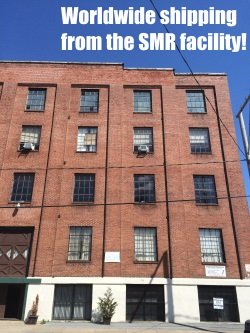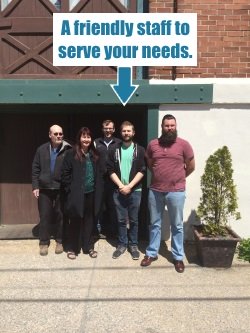Castile Soap Recipe
Today I am going to be demonstrating how to make my castile soap recipe. Within this recipe tutorial, I will be going over some very specific tips and tricks for successfully making a true castile soap. This soap will be scented with a lovely essential oil blend of our grapefruit, pink essential oil and our bergamot essential oil. This grapefruit and bergamot essential oil combination is one of my favorite two oil blends!
Here's a picture of our finished product:
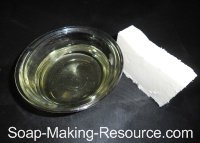
My castile soap recipe will make a 5 pound batch and we will be using one of Soap Making Resource's 5 pound acrylic log soap molds. One of Soap Making Resource's 5 pound wooden soap mold would also work fine for this batch.
So, what exactly is castile soap? The true definition of castile soap is a soap made with only saponified olive oil. Castile soap is indeed a 100% olive oil soap.
It is common within the small batch and homemade soap making industry to consider any soap made with vegetable oils and excluding all types of animal fats, to be a castile soap. According to the true definition of castile soap, this is actually not correct.
Below you will find my exact castile soap recipe formula. This castile soap recipe may seem simple as it has very few ingredients, but be sure to review each step as there are vital methods for making a soap using 100% olive oil.
- Olive Oil (Grade A) = 56 Ounces (100% of total oils)
- Grapefruit (Pink) Essential Oil = 43 grams (1.5168 Ounces)
- Bergamot Essential Oil = 32 grams (1.1288 Ounces)
- Distilled Water = 17 ounces
- lye = 7.359 ounces (208 grams)
*This recipe has a 3% super-fat.
*All measurements are weight measurements, not liquid measurements.
Below is the step by step process for making my castile soap recipe...
|
Sign Up Today!
*Your information is SAFE with us! |
Step 1) Our very first step is to make the lye solution for our castile soap recipe. Measure out 208 grams of dry lye into a heat and chemical safe container. Be sure to measure out your lye in grams as using this small unit of measurement is much more accurate than measuring in ounces.
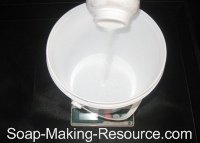
Next, measure out your 17 ounce distilled water portion. Be sure to do this in a heat and chemical safe container.
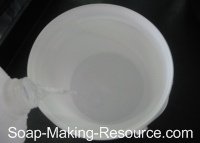
For this castile soap recipe, we are actually using a little bit less water than we normally would to create our lye solution. This "water discount" is highly recommended when making a 100% olive oil soap as it will help to create a harder bar and reduce your finished product's cure time. Most castile soap recipe formulas produce very soft products as there are no solid oils within a true castile soap, so we will do whatever we can to promote hardness within this batch.
Keep in mind that this slight "water discount" will result in a stronger lye solution which will consequently be more caustic and dangerous. So, as always, be sure to wear all the appropriate soap safety equipment, like goggles and rubber gloves, when making this batch. I also highly recommend that you keep a bottle of vinegar nearby to pour over any accidental lye spills. Vinegar will neutralize sodium hydroxide.
Finally, pour your dry lye into your measured out distilled water and stir simultaneously with a heat and chemical safe mixing utensil.
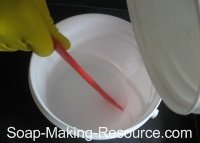
As you combine the lye and water, you will notice instantly that your solution will begin to rapidly increase in temperature. This reaction will also produce a strong, noxious fume. Be sure to avoid breathing in these lye vapors and always create your lye solution outside or in a well-ventilated area away from children and pets.
At this point, your lye solution has been created successfully. Place a thermometer into the liquid and set it safely off to the side for future use. We will need this lye solution to drop in temperature to below 110 degrees Fahrenheit.
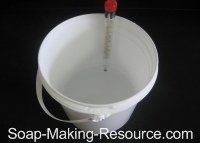
Step 2) Next, we need to measure out our soap making oils into our stainless steel soap making pot. Because this is a true castile soap recipe, we will only need to measure out our 56 ounces of Soap Making Resource's grade A olive oil.
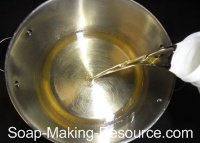
Step 3) Unlike most of our other soap recipes, this true castile soap recipe does not have any hard oils within its formula that require melting, however, we still need to warm up the olive oil to approximately 110 degrees Fahrenheit using a low setting on our cooktop burner. Place a thermometer into the olive oil and begin to heat it up. Be sure to monitor your oil's temperature constantly as you don't want it to overheat.
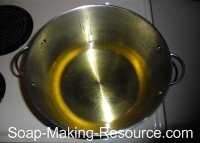
Step 4) While our olive oil is heating up and our lye solution continues to cool, we are going to prepare the additives needed for our recipe. For this castile soap recipe, our only additives will be the two essential oils found within our essential oil blend.
In separate containers, measure out 43 grams of Soap Making Resource's grapefruit, pink essential oil and 32 grams of Soap Making Resource's bergamot essential oil. These two natural essential oils blend wonderfully together!
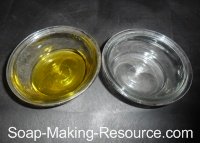
I personally like to measure out my essential oils for my blend in separate containers like this because it allows me to remove a specific essential oil if I accidentally over pour one of them while preparing the blend. Obviously, if you were measuring your essential oils into each other, removing a specific oil, if need be, would not be possible as they would have already mixed together.
Now combine the essential oils into one container so that the blend is ready to be added to your batch when the time comes.
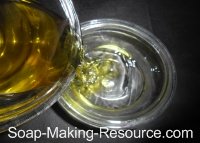
Step 5) While we were preparing our grapefruit-bergamot essential oil blend, our oils have most likely warmed to the desired temperature. Remember, for this batch, we want the olive oil to have a temperature of around 110 degrees Fahrenheit before we use it to make our pure castile soap. Keep in mind that our olive oil doesn't have to be exactly 110 degrees Fahrenheit. This temperature is simply an approximate preferred temperature for making this castile soap batch. Somewhere in between 100 degrees and 110 degrees Fahrenheit will be just fine for making this batch successfully.
Remove your soap making pot from the burner and check the temperature of your olive oil. If the olive oil is above 110 degrees Fahrenheit, you can cool it down by placing your soap making pot in a sink filled with ice water. At this point, you should also check the temperature of your lye solution as you can also use this same method to cool down your lye if needed.
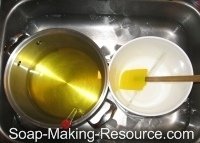
If your lye solution has fallen to an unacceptable temperature, keep in mind that you can always carefully use a "hot water bath" to bring the temperature of your lye and water mixture back up to your desired temperature. To accomplish this, use the same exact method as described above, except fill your sink with hot water instead of cold ice water. Of course, if you need to raise the temperature of your oils, you can always put the soap making pot back onto your cooktop burner and warm them using the same low heat setting.
Step 6) At this point, your olive oil and lye are adjusted to your desired temperature and your additives are prepared and ready to be added to the castile soap recipe batch when they are needed. We are finally ready to make soap!
Slowly pour your lye solution into the warm olive oil and mix manually using a heat and chemical safe mixing utensil.
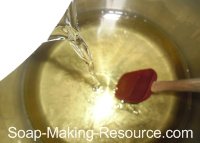
Remember, this lye solution is stronger than normal due to our water discount, so use precautions when pouring!
Keep stirring your olive oil and lye mixture manually until you achieve an even texture and color.
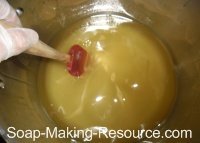
Now that the oil and lye components have been initially combined, pour in your grapefruit and bergamot essential oil blend. Doesn't it smell incredible!
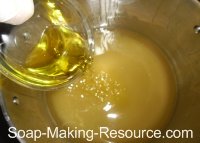
Stir in the essential oils until once again you achieve an even texture and color.
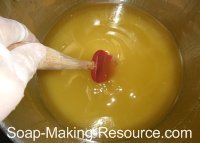
Now, to speed things up a bit, begin mixing your castile soap recipe batch with your stick blender.
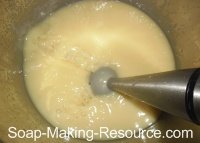
Keep mixing until your batch achieves trace. You can test for trace by dribbling a small amount of soap batter onto the surface of the rest of your batch. If the dribbled soap sets on top of the rest of the batch, even if just for a few moments, you have reached trace and your soap is ready to pour into a mold.
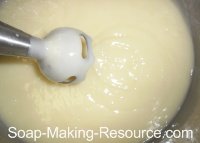
Step 7) Now that your castile soap recipe batch is complete, pour the soap into a mold. This is a 5 pound batch, and as you can see in the picture below, we are using a Soap Making Resource 5 pound acrylic log soap mold.
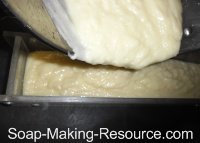
Step 8) Allow your soap to set in the mold for approximately 24 - 36 hours, or until the log is hard enough to remove from the mold without damage. Keep in mind that because this is a true castile soap recipe and our formula was made up of 100% olive oil, it may take longer to solidify than most batches.
As you can see in the picture below, it is very easy to remove your soap log from a Soap Making Resource no-line acrylic mold without damage. Simply set the soap pusher stands beneath the mold and slide them into the appropriate base holes, apply an even downward pressure and pop the soap log right out. Simple! Be sure to check out our video demonstration on how to use a Soap Making Resource acrylic log soap mold!
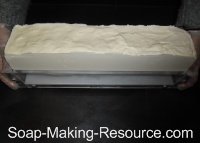
Step 9) Next, cut your soap log into individual bars. You can use a wire soap loaf cutter or a guided soap cutter to accomplish this step. Of course, either method will allow you to slice even, professional looking bars quickly and easily. As you can see in the picture below, for this batch, we decided to use the Soap Making Resource wire soap loaf cutter.
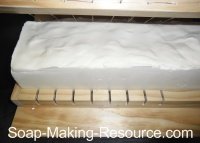
Step 10) Finally, set your finished bars on a rack to cure.
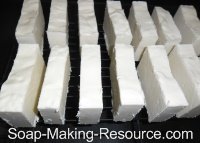
For most cold process soap batches, I recommend that you allow your soap to cure for about 4 - 6 weeks. This castile soap recipe, however, will require a bit more time to adequately harden. Many castile soap makers allow their finished bars to cure for about 4 - 6 months before using or selling them! I know... it's a long time, but I can tell you that it is definitely worth the wait! Now keep in mind that your freshly made castile soap is perfectly safe to use after just a few days, but this extended cure time will allow your bar to become a harder, gentler and longer lasting product.
We designed this castile soap recipe formula specifically to combat softness as much as possible. You may have noticed that this batch has only a 3% superfat level. For almost all of our recipes, we typically use a 5% superfat level. Our superfat percentage was purposely cut back for this recipe to help promote hardness within our finished castile soap. Less excess fat within your soap will inevitably help create a harder finished product.
We have also discounted our water we use within this batch. Typically, we use about a 28% lye solution, but for this soap, we used a 30% lye solution. This discount in our liquid portion will also help the bar to harden more quickly.
I just recently started using some soap bars from a 100% olive oil castile soap recipe batch that I had created over a year ago. I'll tell you what... that soap is divine and yes, very hard! In fact, the castile soap from that long-ago batch is one of my all-time favorite soap bars that I have ever used. This gentle, yet cleansing soap has a wonderful lather that is creamy and robust. Yes... after time, even a 100% olive oil soap will produce a great lather!
I hope you all enjoyed this tutorial that Soap Making Resource has put together for you! Remember, all ingredients used within this batch are available for purchase right here at Soap Making Resource, your home for quality soap making supplies. Don't forget to browse the rest of soap-making-resource.com for more great soap making tips, tutorials and recipes!
Return from castile soap recipe to the soap recipes hub page.

